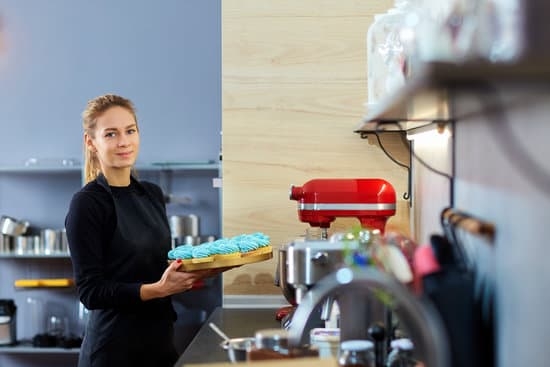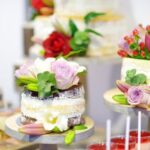Palette knife cake decorating has become a popular technique in the world of cake design, allowing bakers to create stunning and textured designs on their cakes. In this tutorial, we will explore the art of palette knife decorating, providing step-by-step instructions, useful tips, and inspiring ideas for creating beautiful cakes using this versatile tool.
Using a palette knife to decorate a cake involves spreading and manipulating frosting or other edible mediums with a flat blade, resulting in unique textures and patterns. This technique is favored by many cake decorators because it allows them to achieve a contemporary and artistic look that cannot be achieved with traditional piping techniques alone.
The popularity of palette knife cake decorating stems from its ability to create visually striking effects on cakes. From smooth finishes to textured landscapes, the palette knife provides endless possibilities for artistic expression. Whether you’re looking to create an abstract design or a realistic floral motif, mastering the art of palette knife decorating will open up new creative avenues for your cake designs.
In the following sections of this tutorial, we will delve into the different types of tools used in palette knife decorating, provide tips for preparing your cake canvas for optimal results, introduce basic and advanced techniques using a palette knife, troubleshoot common challenges that may arise during the process, and offer inspiring ideas for creating unique designs on your cakes. So let’s get started and unlock the potential of the versatile palette knife in cake decorating.
Choosing the right tools
Palette knife cake decorating requires specific tools to achieve the desired effects and textures on cakes. Choosing the right palette knife is crucial for successful cake decorating. There are various types of palette knives available, each with its own unique shape and purpose. Exploring these different types of palette knives will help decorators understand which ones are best suited for their specific needs.
One common type of palette knife used in cake decorating is the offset spatula. This tool has a flexible, angled blade that allows for precise control when spreading frosting or smoothing surfaces. The offset design helps to keep hands away from the cake, preventing any unwanted smudging or damage. Offset spatulas also come in different sizes, ranging from small to large, which makes them versatile for both detailed work and covering larger areas.
Another type of palette knife frequently used in cake decorating is the straight spatula. These knives have a straight-edged blade that is ideal for spreading frosting evenly across large surfaces or creating sharp edges on cakes. The straight spatula comes in various sizes as well, providing options depending on the size of the cake being decorated.
It’s also worth mentioning the palette knife with a serrated edge. This type of knife is particularly useful when working with buttercream or ganache. The serrated edge helps create texture and decorative patterns on the surface of the cake, adding interest and dimension to the design.
Overall, choosing the right tools for palette knife cake decorating is essential to achieve professional-looking results. By exploring the different types of palette knives available and understanding their uses in cake decorating, decorators can select the appropriate tools that will make their creative vision come to life.
| Type | Description | Uses |
|---|---|---|
| Offset Spatula | A flexible, angled blade | Precise control, spreading frosting, smoothing surfaces |
| Straight Spatula | A straight-edged blade | Spreading frosting evenly, creating sharp edges |
| Serrated Edge Palette Knife | A palette knife with a serrated edge | Creating texture and decorative patterns on the cake surface |
Preparing your cake canvas
When it comes to palette knife cake decorating, one of the most crucial aspects is preparing the cake canvas. This step lays the foundation for a smooth and flawless finish on your decorated cake. Here are some tips to help you achieve the perfect cake base:
- Leveling and torting: Before you begin decorating, it’s important to level your cake layers so that they are even and flat. Use a serrated knife or a cake leveler to carefully trim off any domed tops. Torting, which involves slicing each layer horizontally into two or more equal parts, can also be done if you want to add fillings between the layers.
- Crumb coat: Applying a crumb coat is an essential step in creating a smooth surface for your palette knife technique. Simply spread a thin layer of buttercream frosting over the entire cake using a palette knife or an offset spatula. This will help seal in any loose crumbs and create a solid foundation for the final layer of frosting.
- Chill and set: After applying the crumb coat, it’s important to refrigerate your cake for about 15-30 minutes. This allows the frosting to firm up and makes it easier to apply the final layer smoothly without disturbing any crumbs.
- Final frosting layer: Once your crumb coat has chilled, you can now apply the final layer of frosting using your palette knife. Start by adding generous dollops of frosting on top of the cake and use broad strokes with gentle pressure to spread it evenly across all sides. This step requires patience and practice as it determines how smooth your finished base will be.
| Tips | Description |
|---|---|
| Leveling and torting | Trim off any domed tops and slice each layer horizontally into two or more parts |
| Crumb coat | Apply a thin layer of buttercream frosting to seal in loose crumbs |
| Chill and set | Refrigerate the cake for 15-30 minutes after applying the crumb coat to firm up the frosting |
| Final frosting layer | Add generous dollops of frosting and spread it evenly using broad strokes with gentle pressure |
By following these tips, you will be able to achieve a smooth and flawless surface on your cake, providing a perfect canvas for palette knife decorating. Taking the time to properly prepare your cake base will greatly enhance the overall aesthetic and professional look of your finished design.
Getting started
One of the most important aspects of successfully decorating a cake with a palette knife is learning how to properly hold and control the tool. This section will provide step-by-step instructions on how to achieve the correct grip and maintain control throughout your decorating process.
- Start by selecting a palette knife that feels comfortable in your hand. It should have a sturdy handle that allows for a secure grip. Many cake decorators prefer palette knives with flexible blades, as they allow for more control and precision.
- Grasp the handle of the palette knife firmly, but not too tightly, as this can restrict movement and control. The index finger should be placed on top of the handle near the blade, while the remaining fingers wrap around the handle.
- Position your arm and body in a way that allows for stability and control. Resting your elbow on a stable surface, such as a table or countertop, can help provide support and reduce shaking or wobbling.
- When starting to decorate with the palette knife, it is important to use light pressure and gentle movements. Begin by spreading a thin layer of frosting or icing onto your cake using broad strokes.
- As you become more comfortable with holding and controlling the palette knife, experiment with different angles and techniques. Holding the palette knife at an angle can create different effects, such as creating texture or blending colors.
- Practice is key when it comes to mastering the art of holding and controlling a palette knife while decorating cakes. Take your time, be patient, and keep experimenting with different techniques until you find what works best for you.
By following these step-by-step instructions on how to properly hold and control a palette knife while decorating cakes, you will be well on your way to creating beautiful designs with ease and precision. Remember to practice regularly and have fun exploring all of the possibilities that this versatile tool has to offer in cake decorating.
Basic techniques
When it comes to palette knife cake decorating, mastering the basic techniques is essential for achieving professional-looking results. Whether you’re a beginner or an experienced baker looking to enhance your skills, understanding how to properly spread, blend, and create texture with a palette knife is crucial. Here are some fundamental techniques to get you started:
- Spreading: Spreading icing or frosting evenly across the surface of a cake is one of the most basic yet important tasks in cake decorating. To achieve a smooth finish, start by applying a generous amount of icing onto the cake using a palette knife.
Hold the knife at a slight angle and use long, even strokes to spread the icing from the center outward. Continue this motion until the entire surface is covered, periodically wiping excess frosting off the knife. - Blending: Blending different colors of icing can add depth and dimension to your cake design. To blend colors seamlessly using a palette knife, start by applying two different shades side by side on the cake. With a clean palette knife, gently drag it through both colors in a zigzag or swirling motion. Repeat this process until the colors begin to blend together smoothly.
- Creating texture: Adding texture can elevate your cake design from plain and flat to visually interesting and dynamic. With a palette knife, you can create various textures such as waves or peaks on your cake’s surface. Experiment with different techniques like dragging or stippling the icing with the edge or flat side of the knife. This will give your cake depth and provide an intriguing tactile element.
By familiarizing yourself with these basic techniques, you can lay a solid foundation for exploring more advanced palette knife techniques in your cake decorating journey. Practice these fundamental skills to build confidence and develop your own unique style when working with this versatile tool.
- Spreading: Apply a generous amount of icing and use long, even strokes to spread it across the cake.
- Blending: Apply two different shades of icing side by side and gently drag a clean palette knife through them until they blend together smoothly.
- Creating texture: Experiment with dragging or stippling the icing using the edge or flat side of the palette knife to create various textures on your cake.
Creating artistic designs
Creating artistic designs with a palette knife can take your cake decorating to the next level. This section will provide you with inspiring ideas and examples of how to use palette knives to create stunning designs, patterns, and effects on cakes. With the versatility of this technique, you can unleash your creativity and make unique and eye-catching cakes.
Floral designs
One popular way to use palette knives is to create beautiful floral designs on cakes. You can use different colors of buttercream or icing to imitate flowers like roses, peonies, or sunflowers. Start by using the edge of the palette knife to form the petals, gradually adding more layers for a realistic effect. Don’t forget to add details like leaves and stems using a smaller palette knife or a piping bag.
Geometric patterns
If you prefer a modern and abstract look, try creating geometric patterns using a palette knife. Use contrasting colors and straight edges of the palette knife to achieve sharp lines and angles. You can experiment with different shapes like triangles, squares, or even intricate patterns like chevron or herringbone.
Textured effects
Palette knives are excellent tools for adding texture and dimension to your cakes. You can achieve various effects such as waves, ruffles, or wood grain by gently dragging the flat side of the palette knife across the icing or buttercream. Experiment with different pressures and angles for unique results that add depth and interest to your cake design.
Remember that practice makes perfect when it comes to creating artistic designs with a palette knife. Don’t be afraid to experiment with different techniques and color combinations until you find what works best for you. The possibilities are endless when it comes to utilizing this technique in cake decorating – let your imagination run wild.
Troubleshooting and tips
While palette knife cake decorating can produce stunning results, it can also come with its fair share of challenges. However, with a few helpful tips and tricks, you can overcome common obstacles and achieve professional-looking results that will impress both yourself and your guests.
One common challenge in palette knife cake decorating is achieving a smooth surface on your cakes. Uneven surfaces can make it difficult to create clean lines or blend colors seamlessly. To ensure a smooth base, it’s important to properly level and trim your cakes before applying any frosting or decoration. This will provide you with a flat surface to work on.
Another tip is to chill your cake layers before frosting them. By refrigerating the layers for about 30 minutes prior to decorating, you’ll reduce the risk of crumbs mixing into your frosting as you spread it with the palette knife. This simple step can help you achieve a cleaner finish on your cakes.
When it comes to spreading the frosting with a palette knife, one challenge many beginners face is obtaining even coverage. To prevent uneven patches or gaps in your frosting, start by applying a thin layer of frosting over the entire cake before adding more for additional coverage. This initial layer acts as a “crumb coat” which seals in any loose crumbs and provides a smoother surface for subsequent layers of frosting.
Another helpful tip is to regularly clean and warm up your palette knife while working. Wiping off excess frosting from the knife after each stroke will help maintain clean lines and prevent smearing. Additionally, dipping the palette knife in warm water occasionally can help soften the buttercream or ganache, making it easier to spread smoothly onto the cake.
By addressing these common challenges and implementing these tips, you’ll be well on your way to achieving professional-looking results in your palette knife cake decorating endeavors. Remember, practice is key, so don’t be discouraged if your first few attempts don’t turn out perfectly. With time and experience, you’ll develop the skills and confidence to create stunning cakes using palette knife techniques.
Advanced techniques
Advanced techniques are where experienced cake decorators can truly showcase their skills and creativity using a palette knife. One popular advanced technique is creating ombre effects on cakes. This involves blending two or more colors seamlessly to create a gradient effect that adds depth and dimension to the cake.
To achieve this, start with a base color and gradually add more of the desired color while blending with the palette knife. Use long, smooth strokes to ensure a seamless transition between colors.
Another advanced technique that can be achieved with a palette knife is creating intricate floral designs. Begin by applying a thin layer of buttercream or icing onto the cake as a base. Then, using different shades of colored icing, use the palette knife to create petals and leaves by spreading and shaping the icing in various patterns.
Experiment with different angles of the palette knife to create different petal shapes and textures. These motifs can be combined to form beautiful floral arrangements on the cake.
In addition to floral designs, intricate detailing can also be achieved with a palette knife. By carefully controlling the pressure and angle of the palette knife, it is possible to add delicate lines, scrolls, or patterns onto the cake’s surface. This technique requires precision and practice, as it involves steady hand movements for clean lines and consistent shapes.
These advanced techniques may require some patience and practice to master, but they can elevate your cake decorating skills to new heights. Remember that experimentation is key when exploring these techniques – don’t be afraid to try out different color combinations, patterns, or designs until you find what works best for your vision.
By incorporating these advanced palette knife techniques into your cake decorating repertoire, you’ll be able to create extraordinary cakes that leave a lasting impression on anyone who sees them. The versatility of the palette knife allows for endless possibilities in design and decoration, making it an essential tool for any dedicated cake decorator looking to push their creativity boundaries further.
So don’t be afraid to dive into the world of advanced palette knife techniques and watch your cake decorating skills soar to new heights.
Final touches
When it comes to cake decorating, the final touches can truly elevate a design from ordinary to extraordinary. This is where the palette knife technique can shine, as it offers many opportunities for adding unique and eye-catching finishing touches to your cake. In this section, we will explore how you can use palette knife techniques to add edible decorations and write messages on your cakes.
Adding Edible Decorations
One of the most popular ways to enhance the appearance of a cake is by adding edible decorations using a palette knife. From flowers and leaves to intricate designs and patterns, there are endless possibilities for creating stunning decorations with this versatile tool. To begin, you will need to prepare your icing or buttercream in the desired colors.
Using a clean palette knife, carefully pick up small amounts of color and apply them onto your cake in the desired pattern or shape. You can experiment with different textures and techniques, such as creating petals by dragging the edge of the palette knife through the icing or layering colors to achieve depth and dimension.
Writing Messages
Another way to add a personal touch to your cake is by writing messages using a palette knife. This technique allows you to create beautiful script-like fonts or bold lettering that stands out on the cake’s surface. To get started, ensure that your icing or buttercream is at the right consistency – not too runny or too stiff.
Using a smaller palette knife or even just the tip of your larger one, gently press into the icing while moving your hand in a fluid motion to form letters. Take your time and practice beforehand on parchment paper if needed. Remember that patience is key when it comes to writing messages with a palette knife – don’t rush and take breaks if necessary.
By adding these final touches using palette knife techniques, you can transform an already impressive cake into something truly remarkable. Whether it’s adding delicate edible decorations or writing heartfelt messages, the possibilities are endless. So let your creativity flow and experiment with different designs to make your cakes even more memorable and visually striking. With practice and perseverance, you’ll be able to achieve professional-looking results that will wow your friends, family, and clients.
Conclusion
In conclusion, palette knife cake decorating is a versatile and impressive technique that allows for endless creativity and stunning designs. Throughout this tutorial, we have explored the different types of palette knives, learned how to prepare the cake canvas for optimal results, and discovered various basic and advanced techniques for achieving professional-looking cakes.
By using a palette knife, you have the ability to create texture, blend colors seamlessly, and even add intricate details or floral designs to your cake. The possibilities are truly endless when it comes to using a palette knife as a tool for cake decorating.
I encourage all readers to give palette knife cake decorating a try. It may seem intimidating at first, but with practice and patience, you can achieve beautifully decorated cakes that will impress your friends and family. Remember to start with the basic techniques and gradually work your way up to more advanced ones. Don’t be afraid to experiment and let your creativity flow.
Palette knife cake decorating is not only a fun hobby or skill to learn; it can also become a great source of personal satisfaction as you see your creations come to life. So go ahead, grab your palette knives and start exploring this wonderful world of cake decoration with confidence.
Frequently Asked Questions
What type of buttercream is best for palette knife painting?
The type of buttercream that is best for palette knife painting is Swiss meringue buttercream. Swiss meringue buttercream has a smooth and creamy texture, making it easy to work with when using a palette knife.
It also holds its shape well, allowing you to create beautiful textures and designs on the cake surface without the buttercream melting or becoming too soft. Additionally, Swiss meringue buttercream can be easily colored with gel food coloring, giving you the ability to use a wide range of colors in your palette knife painting.
How do you make flowers with a palette knife on a cake?
To make flowers with a palette knife on a cake, start by preparing your desired colors of buttercream frosting. Using different hues of the same color will give dimension and depth to your flowers. With a clean palette knife, load a small amount of one color at a time onto the tip of the knife. Hold the palette knife at an angle and gently press down onto the cake surface, making small petal-like strokes in a circular motion to create flower petals.
Repeat this process with different colors until you have achieved the desired flower shape and look. You can also use the edge or corner of the palette knife for finer details or to add stamen in the center of each flower. Experimenting with different techniques and color combinations will allow you to create unique floral designs on your cake.
How to do palette knife texture art?
Creating texture art with a palette knife involves using the flat edge or sides of the knife to apply thick layers of paint (or other medium) onto a canvas or surface. To begin, select your desired colors and prepare them on your palette or mixing tray. Dip the edge or side of the palette knife into one color at a time, ensuring that it is evenly coated across the blade but not overloaded with paint. Next, apply the paint onto your canvas by dragging or scraping it across in various directions to form texture and patterns.
You can layer different colors on top of each other or mix them directly on the canvas to create unique effects. Experiment with different pressures and angles of the palette knife to achieve the desired texture and look. Remember to let each layer dry before adding more paint on top, as this will help preserve the distinct textures created by the palette knife.

Welcome to our cake decorating blog! My name is Destiny Flores, and I am the proud owner of a cake decorating business named Cake Karma. Our mission is to provide delicious, beautiful cakes for all occasions. We specialize in creating custom cakes that are tailored specifically to each customer’s individual needs and tastes.





